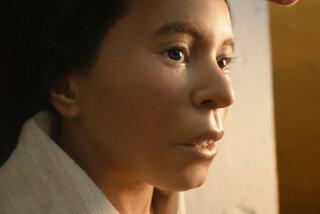Examination of Mummy Solves a Mystery of the Age
- Share via
SAN DIEGO — A Peruvian mummy, on exhibit in a local museum for years as a specimen of an ancient infant, actually is the remains of a teen-ager or a young adult, a team of scientists said Friday.
San Diego radiologist Hano A. Siegel said he and his colleagues asked the Museum of Man here if they could examine the contents of a Peruvian sarcophagus in mid-July and recently completed their findings.
Siegel, an executive with the Radiology Medical Group of San Diego, said the series of X-rays and CAT (computer-assisted tomography) scans proves that the body inside was “at least an early teen-ager,” even though it was less than three feet long.
“It was shriveled up in the fetal position,” Siegel said. “The museum people had thought for years it was an infant, but the scan showed it didn’t have an infant’s bones. The other doctors were all in agreement. Anyone who would have looked at it would have assumed it was an infant.”
The person’s height would have been between 2 feet, 10 inches, and 3 feet, 6 inches, he said, small by modern standards but not for some ancient populations of Peruvian Indians. The mummy is believed to be more than 1,000 years old.
Siegel was assisted by Dr. Myron Marx, a San Francisco radiologist who has examined Egyptian mummies, and Dr. Ethan Braunstein, a New York radiologist who specializes in anthropological research.
Rose Tyson, curator of physical anthropology at the Museum of Man in Balboa Park, near the San Diego Zoo, said the mummy was loaned to the museum in 1936 and finally given as a gift in 1978.
It has been on exhibit, labeled as an infant, she said, “but we’ll have to change our labeling.
More to Read
Sign up for Essential California
The most important California stories and recommendations in your inbox every morning.
You may occasionally receive promotional content from the Los Angeles Times.













